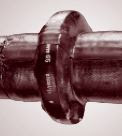How do I Know What Size to Order: FS-Flangeseal and AQW-FPK (Flange Protection Kit)
 |
| An installed Covalence FS (Flangeseal) |
Coating a flange can be tricky. You've typically got a significant size difference between the outside diameter of the flange - and the diameter of the pipeline. You've also got a number of bolts that could have sharp edges. You've got a gasket of some kind that you'd likely don't want to covered in anything permanently (that would prevent you from re-entering that flange if it was necessary. You've also likely got some amount of uncoated pipe where the flange is welded in. There are a lot of important data points there. Let's try and break it down so it is a bit simpler.
Typical flangeseal nomenclature will be something like this (I'll give a few examples):
FS 24000-24 -- this is for a flange with an ACTUAL OD of 24.0". This FS is supplied 24" wide (we'll get more into that below).
FS 36000-36 -- an FS for a 36" OD Flange that is supplied at 36" wide.
FS 12750-24 -- an FS for a 12.75" OD Flange that is supplied at 24" wide.
So, the first number is VERY important! That tells us how to make the Flangeseal so that is long enough to wrap all the way around the flange and meet back up with itself. An FS 12750 would never work on a 24" OD flange --- it would be like someone with a 36" waist trying to button up jeans that are made for a 22" waist.
The second number is the width of the flange as supplied. That is slightly trickier to figure out. Let's say you are working with a 24" OD Flange and a 12.75" OD Pipe. In addition, let's say that flange is 4 inches wide itself and there are 4 inches of uncoated pipe where the pipe and flange connect.
First thing I look at: 24" OD flange down to a 12.75" OD pipe. Picture the sleeve installed. The sleeve is going to 'step down' from the peak of the flange down to the pipe surface and nearly 6" of the sleeve "width" is going to be lost on that vertical of the sleeve shrinking. Does that make sense? Simplify it by picturing yourself cutting a strip of duct tape that spans from your kitchen island down to the floor and across to the wall. You would have to measure - the number of inches you want it to be attached to your kitchen island -- and the distance from island to floor -- and the distance across floor to wall. In this paragraph - the step down from outermost flange to pipe is like the distance from the kitchen island to the floor.
So right there - with this 24" to 12.75" dimension we know we are going to lose 6" of our sleeve width TWO TIMES (have to figure this step down will happen on both sides of the flange. So that is 12" of our width "used" already. In addition - the flange is 4" across (which includes where the bolts are, etc). We've now used 16" of our sleeve width (12+4).
Now let's add in that there are 3" of bare steel adjacent to the flange on both sides. That is 6" of bare steel (total - we have to add them together) AND we still need to overlap onto good pipe coating by at least 3" per side (another 6").
That leaves us (in terms of sleeve width) with:
- 12" of width used to bridge the gap between flange and pipe
- 4" of width used to cover the flange itself
- 6" of width used to cover bare steel
- 6" of width used to overlap onto good coating
12 + 4 + 6 + 6 = 28"
The minimum FS width that could work on this configuration is 28". Our standards are 24" and 35.5" --- so the only option here is to use a 36" wide Flangeseal (24" would not properly seal).
No comments:
Post a Comment